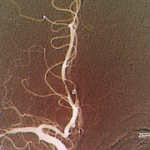Susac Syndrome
Susac syndrome is an immune-mediated, occlusive microvascular endotheliopathy of the brain, inner ear and retina. John Susac, MD, was the neurologist who first described the syndrome in 1975.1 Since 2021, more than 450 cases of Susac syndrome have been published worldwide. Epidemiologic data are limited because the disease remains underdiagnosed and delays to diagnosis are common.
Susac syndrome affects the brain, retina and inner ear, primarily affecting young adults. It’s manifested by a triad of encephalopathy, sudden unilateral, sensorineural hearing loss and branch retinal artery occlusions. Brain MRIs typically show disseminated lesions that involve the corpus callosum.2

Dr. Furer
“Prompt recognition of an underlying immune-mediated and/or inflammatory disease is important [because] early diagnosis and treatment prevent permanent disability,” said Dr. Furer. “Recognition of specific patterns of involvement can serve as diagnostic clues.”
Differential Diagnoses
After ruling out infection, malignancy and toxic etiologies, the differential diagnoses of brain, ear, eye syndromes fall into three categories:
- Demyelinating diseases, such as multiple sclerosis (MS) and neuromyelitis optica spectrum disorder;
- Rheumatic inflammatory systemic diseases, such as SLE, Behçet disease and sarcoid; and
- Rare diseases that stand alone, such as Susac syndrome, Vogt-Koyanagi-Harada syndrome and Cogan syndrome.
MS is the most common immune-mediated, inflammatory, demyelinating disease of the central nervous system (CNS). It can cause visual symptoms, with 50% of patients having optic neuritis. It may cause sudden unilateral, sensorineural hearing loss in 4% of patients and can be followed by bilateral sensorineural hearing loss.3
Neuromyelitis optica spectrum disorder is an inflammatory condition of the CNS characterized by severe, immune-mediated demyelination and axonal damage, predominantly targeting the optic nerves and multiple segments of the spinal cord. Bilateral optic neuritis can cause severe visual loss, and sudden unilateral or bilateral, sensorineural hearing loss is more common than in MS due to cochlear nuclei lesions.4
“Corpus callosum lesions can occur in both MS and NMOSD,” said Dr. Furer. “So it’s important to consider these [conditions] in the differential diagnosis. Lesions have a different radiographic appearance, and radiology can help differentiate them from Susac syndrome.”
Neuropsychiatric SLE can have a variable presentation. In the eyes, it may cause dry eye, corneal erosions, ulcerative keratitis, uveitis or lupus retinopathy (i.e., extensive arteriolar occlusions with bilateral macular infarctions). Unilateral or bilateral sensorineural hearing loss may occur too.5
“It’s important to note that neuropsychiatric SLE is radiographically indistinguishable from the appearance of many other etiologies,” said Dr. Furer.

